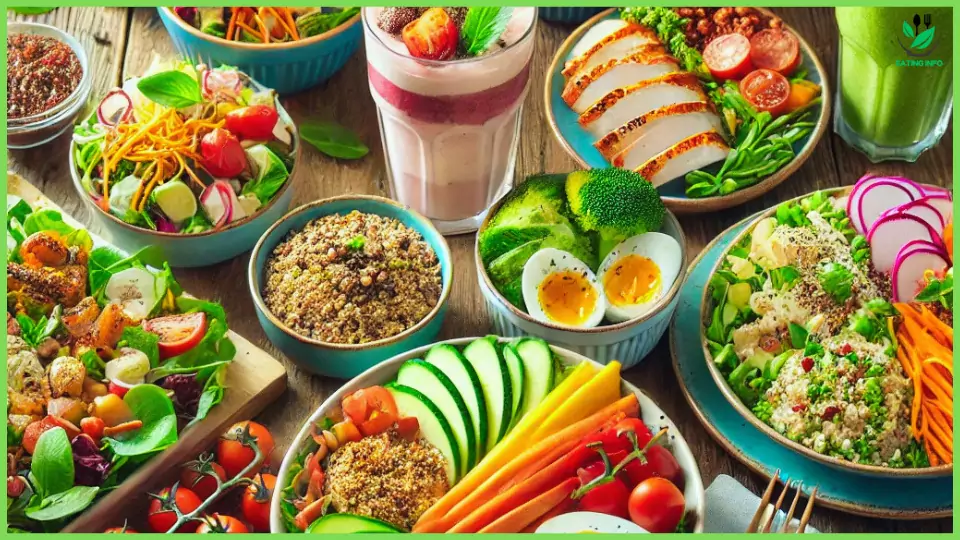A low-kilojoule lunch does not have to mean a boring salad or some flavorless soup. You can make some flavorful, satisfying, yet healthy meals without packing in all the unwanted kilojoules, with just the right ingredients and a dash of imagination. Whether you want to drop those extra pounds, sustain your energy levels, or just enjoy a nutritious meal, these 10 ideas will elevate your lunchtime game.
What Is a Low-Kilojoule Lunch?
Low-kilojoule lunches focus on meals that are light in energy density but high in nutrients. By eating foods rich in vitamins, minerals, and fiber, you can stay satisfied while keeping your daily kilojoule intake under control.
Benefits of Eating Low-Kilojoule Meals
- Weight Management: Reducing kilojoule intake can help create a calorie deficit necessary for weight loss.
- Increased Energy: Nutrient-dense foods provide sustained energy without the post-meal slump.
- Improved Health: A balanced low-kilojoule diet reduces the risk of chronic diseases such as diabetes and heart disease.
Common Misconceptions About Low-Kilojoule Lunches
- Bland Taste: Many assume low-kilojoule foods are flavorless, but that couldn’t be further from the truth when you use the right ingredients.
- Insufficient Satiety: Feeling hungry after meals is usually due to imbalanced macronutrients, not necessarily low kilojoules.
The Principles of a Balanced Low-Kilojoule Lunch
Understanding Macronutrient Ratios
A well-balanced lunch includes lean proteins, healthy fats, and carbohydrates from vegetables or whole grains. This combination helps regulate hunger hormones and keeps you full longer.
Why Portion Control Matters
Even the healthiest foods can lead to excessive kilojoules if not portioned properly. Use tools like food scales or portion plates to measure serving sizes.
Creative Ways to Upgrade Your Low-Kilojoule Lunch
1. Add a Protein Punch
Protein is crucial for satiety and muscle maintenance. Upgrade your lunch by incorporating lean proteins like grilled chicken, tofu, boiled eggs, or legumes.
- Tip: Mix a cup of lentils into your salad or try a Greek yogurt-based dressing for added protein.
2. Spice It Up with Herbs and Seasonings
Herbs and spices add a world of flavor without extra kilojoules. Consider options like paprika, cumin, fresh dill, or basil.
- Tip: A squeeze of lemon or a dash of balsamic vinegar can elevate flavors while keeping things light.
3. Swap Carbs for Veggies
Replace high-kilojoule carbs like white rice or bread with vegetable alternatives. Think zucchini noodles, cauliflower rice, or lettuce wraps.
- Tip: Spiralized veggies are a fun and nutritious alternative to pasta!
4. Incorporate Fermented Foods
Fermented foods like kimchi, sauerkraut, or pickles enhance digestion and provide probiotics.
- Tip: Add a spoonful of kimchi to your lunch bowl for a tangy kick.
5. Experiment with Healthy Wrap Alternatives
Ditch traditional wraps and go for lower-kilojoule alternatives like collard greens, rice paper, or nori sheets.
- Tip: Try making sushi-style wraps filled with fresh vegetables and lean protein.
6. Include a Rainbow of Vegetables
Eating a variety of colorful vegetables ensures a broad spectrum of nutrients.
- Tip: Bell peppers, carrots, purple cabbage, and spinach not only add nutrition but also make your meal visually appealing.
7. Use Broth-Based Soups
Soups made with clear broths are filling and low in kilojoules compared to their creamy counterparts.
- Tip: Add protein and vegetables to your broth for a complete meal.
8. Add Crunch with Nuts and Seeds
A scattering of nuts or seeds can add healthful fats and improve texture. Choose pumpkin seeds, chia seeds, or almonds.
- Tip: Use a small handful to keep the kilojoule count in check.
9. Try Low-Fat Dairy or Alternatives
Low-fat cheeses, yogurt, and plant-based alternatives like almond or soy products are excellent additions.
- Tip: Whip up a yogurt-based dip with garlic and herbs for a guilt-free side.
10. Don’t Forget a Satisfying Dressing or Dip
A good dressing can transform a meal. Use avocado, hummus, or tahini-based sauces instead of high-fat options.
- Tip: Try making your dressing with olive oil, lemon juice, and mustard for a zesty flavor.
Tips for Preparing Low-Kilojoule Lunches on a Budget
Meal Prep Hacks for Success
- Cook in bulk and portion meals ahead of time.
- Invest in reusable containers for easy grab-and-go options.
Smart Grocery Shopping Tips
Shop seasonal produce to save money.
Buy in bulk for staples like grains and legumes.
Upgrading your low-kilojoule lunch doesn’t mean sacrificing flavor or satisfaction. By focusing on nutrient-dense ingredients, balanced macronutrients, and creative preparation techniques, you can enjoy delicious meals that support your health goals.
FAQs
1. What are some quick low-kilojoule lunch ideas?
Try salads with grilled chicken, veggie wraps, or broth-based soups for quick options.
2. Can I meal prep low-kilojoule lunches for the week?
Absolutely! Prepare ingredients in advance and store them in individual containers.
3. Are low-kilojoule lunches suitable for everyone?
Yes, but individual kilojoule needs vary. Consult a nutritionist if unsure.
4. How can I add variety to my low-kilojoule meals?
Experiment with different vegetables, proteins, and international cuisines for variety.
5. Is it expensive to eat low-kilojoule meals?
Not at all. With smart shopping and meal prep, low-kilojoule meals can be budget-friendly.

